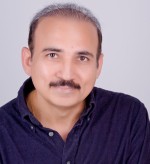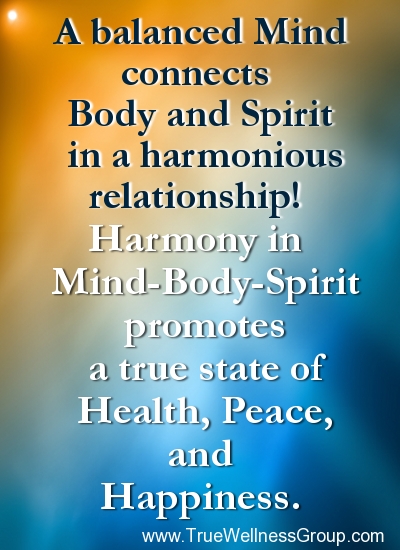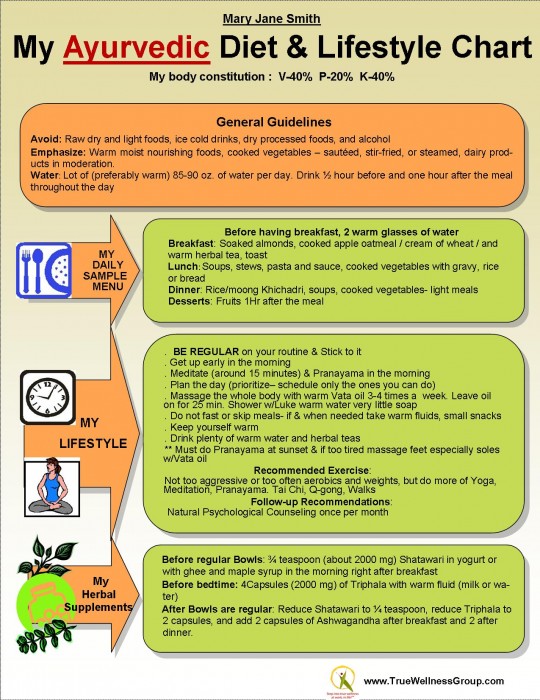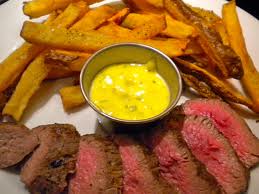Posts Tagged ‘Health Coaching’
How Can You Identify Presence of Ama (Toxins)?
You might ask, what is Ama? In Ayurvedic medicine, accumulation of Ama is responsible for most of the diseases, from a simple bloating/gas to complex and deadly diseases like cancer. So detecting the presence of Ama (beginning of accumulation) in your body is extremely important.
The most fundamental factor in keeping healthy is to have healthy digestion which requires balanced digestive fire for proper optimum digestion. If the digestive fire becomes weak and dull (due to reasons discussed in my book “Health + Happiness = Wellness”), the digestion gets impaired. As a result toxins or Ama is produced and if left unchecked, the accumulation of Ama continues.
Following is a common list of symptoms to look out for in identifying presence of Ama in your body:
- Coated tongue (stays coated throughout the day)
- Weak hunger (Lack of desire to eat)
- Feeling of heaviness in GI Tract
- Gas/bloating almost after every meal
- Gases with foul odor
- Foul odor in sweat
- Heaviness and feeling lazy (Lack of energy)
- Frequently feeling fatigued
- Stiffness in body, lumber region, spine or joints
- Incomplete or unsatisfactory bowl movements
- Sticky, poorly formed stools that usually sink with foul odor
- Frequent urine with foul odor
If you are experiencing any of these symptoms frequently, it is time to do the cleansing or detoxifying. Fasting and exercising (though not together) are the best way to “burn” Ama and cleanse the body systems. You can read more in another article “How to Detoxify Your Body” or in the book “Health + Happiness = Wellness”.
In case you have too much accumulation of Ama, the best course would be to see an Ayurvedic practitioner and perhaps go through “Panchakarma”. Panchakarma is an Ayurvedic protocol for detoxifying the body riddled with toxins in a matter of few days.
Of course your goal should be to catch the symptoms early enough so you can use self practice and less expensive means to detoxify and free your body of Ama or toxins. Wishing you the best!
Read More...
Preventive Care: You Are Your First Doctor
Wouldn’t you agree that no one person on this planet cares more about you than you? Even if the health care system provided disease prevention, health promotion, education to keep both mind and body healthy, and excellent disease management capabilities, you would still need to be your first doctor. Unfortunately, today we do not have a good health management and preventive care system; thus, it is even more important for you to be your first doctor.
What I am saying is that no matter how good health care reforms take place, you still need to be your first doctor. Therefore, start with what you control. Reform yourself to start taking charge of your own health. You need to start understanding your own body’s disease and wellness tendencies. You need to start paying attention to what foods agree with you more and what foods are problematic. You need to become familiar with herbs and spices that are friendly to your body. You need to create a suitable (to you) menu of foods in your daily regimen. The idea here is to use food as your first medicine and the kitchen as your first pharmacy. You will discover how in the next chapter.
The purpose here is for you to heal yourself at the first signs of imbalance (a dynamic model of health). Here, healing means removing the cause behind the symptoms, not just removing the symptoms as is typically done in conventional medicine. If you only remove the symptoms and not the cause, then the cause continues to fester underneath while you continue to suppress symptoms on the surface. This strategy only delays the onslaught of a disease in its more ferocious form. Later, you would require stronger measures to deal with the problem like surgery, stronger medicine, and perhaps developing a lifelong dependency on medication with a risk of side effects.
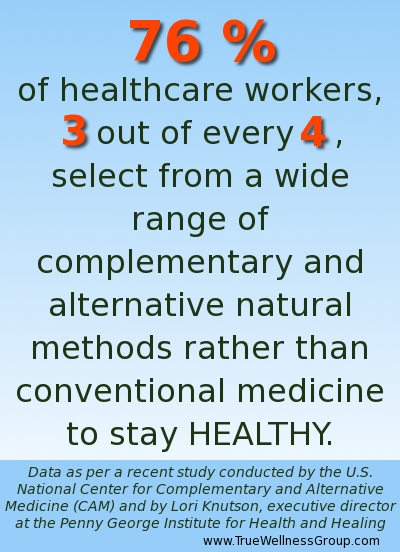 A recent study conducted by the U.S. National Center for Complementary and Alternative Medicine (CAM) and by Lori Knutson, executive director at the Penny George Institute for Health and Healing, pleasantly surprised everyone: 76 percent of healthcare workers, 3 out of every 4, selected from a wide range of complementary and alternative natural methods rather than conventional medicine to stay healthy. Could it be that they see firsthand the side effects of prescription medicine in their patients? Or could it be that they know the medicine will only suppress the symptoms but not remove the cause? Whatever the reason, the important point to note is: Acting as their first doctor, healthcare workers selected natural alternative remedies to stay healthy.
A recent study conducted by the U.S. National Center for Complementary and Alternative Medicine (CAM) and by Lori Knutson, executive director at the Penny George Institute for Health and Healing, pleasantly surprised everyone: 76 percent of healthcare workers, 3 out of every 4, selected from a wide range of complementary and alternative natural methods rather than conventional medicine to stay healthy. Could it be that they see firsthand the side effects of prescription medicine in their patients? Or could it be that they know the medicine will only suppress the symptoms but not remove the cause? Whatever the reason, the important point to note is: Acting as their first doctor, healthcare workers selected natural alternative remedies to stay healthy.
So far, the focus has only been on the physical. What about the mental part? From a holistic point of view, the root cause of the disease primarily lies in the mind. Conventional medicine, for the most part, doesn’t address the mental part of health care; however, to stay healthy, you need to discover the weaknesses and strengths of your own mind. You need to become aware of what situations can trigger an adverse reaction in you. Only you, as your first doctor, can prepare to diffuse the situation and not carry mental “heaviness” or stress from it.
In addition, your spiritual part plays a very important role in helping you shift negative mental attitudes such as selfishness, greed, vengeance, etc. that are causing trouble to your mind. As you develop your spiritual side and become more aware of your mind-body and spiritual connections, either consciously or unconsciously, you discover the capacity to heal (balance) yourself from within. Different sections in “Health + Happiness = Wellness” book cover this subject in more detail.
Read More...
What is an Ayurvedic consultation?
The initial Ayurvedic consultation could last 90 minutes or more. During the first Ayurvedic consultation, the complete focus is on you. Who you are, what makes you unique, and why you have symptoms, if any? In fact, unlike doctor’s visit, you can and should visit Ayurvedic practitioner without any symptoms. The goal here is health promotion and disease prevention.
During the consultation, an Ayurvedic practitioner will:
- Uncover your unique mind-body constitution
- Discover your health history and family medical history
- Learn about state of your current health
- Get into details of your daily diet
- Learn about stresses in your life
- Get to know your lifestyle, exercise regimen, etc.
In Ayurveda you and your health are at the heart of the health care system. Every health recommendation is based around your uniqueness. Shouldn’t a medical system work this way, rather than revolving around a disease? Thus a very important first step in Ayurvedic consultation is to uncover your unique mind-body constitution. It gives Ayurvedic practitioner a clear picture about your unique physic, physiology, and psychology. Your original constitution is your true self in balance and health. When you have any physical or mental health issues, you are out of balance or in altered constitution. The Ayurvedic practitioner’s job is to uncover and remove the cause and restore you back to your original (constitution) balance. Imagine if a health practitioner has no clue what your original unique balance is, how can he/she help restore it?
Receive Your Diet and Lifestyle Chart
 From Ayurvedic consultation, you receive diet and lifestyle chart created specifically to address your health issue and restore balance. After the issue is resolved, a new diet and lifestyle chart suitable for your original mind-body constitution is created. In Ayurvedic medicine, food, spices, and herbs are used as your first medicine. I would suggest you keep this chart in your kitchen and follow it to participate in your health every day.
From Ayurvedic consultation, you receive diet and lifestyle chart created specifically to address your health issue and restore balance. After the issue is resolved, a new diet and lifestyle chart suitable for your original mind-body constitution is created. In Ayurvedic medicine, food, spices, and herbs are used as your first medicine. I would suggest you keep this chart in your kitchen and follow it to participate in your health every day.
The goal of initial Ayurvedic consultation is to fill missing healthy links and eliminate unhealthy revolving around your unique constitution. If you have no issues, visit your Ayurvedic practitioner 1-2 times per year to make adjustments otherwise visit as recommended by practitioner per your situation. Following is an example of Ayurvedic diet and lifestyle chart you receive after the consultation: [View larger version]
“The other day one of my clients told me Rakesh what you are teaching is going to make me self sufficient. I will have no reason to see you again. It seems as if you are working yourself out of business.” Isn’t that what a health practitioner should do- to make you self sufficient?
You can schedule your consultation over Skype, phone or in person. Read what is included in different Ayurvedic Wellness Coaching services here.
Testimonials
“For four years I suffered from chronic fatigue syndrome and fibromyalgia. These diseases are debilitating with flu-like symptoms and extreme fatigue – I needed 14 hours of sleep each day!My illness took over my life, making it impossible to work, take care of my family, and play with my 10-year-old son. After a whopping 15 minutes of analysis, my doctor gave me sleeping pills and antidepressants. He concluded my illness was all in my head! I spent months trying specialists, vitamins, and medications – with no cure in sight. Now I truly was getting depressed and losing hope. A few months ago, I decided to try a more natural approach. I began a program that would take my entire mind, body, spirit, and lifestyle into consideration. My Ayurveda journey with Rakesh Sethi gave me a complete understanding of what my body was going through, why it was responding with this illness, and how to change it. Rakesh guided me through a detoxification process and a new diet, including natural foods, spices, and herbs that were right for my body type. I also incorporated breathing techniques, meditation, and yoga. After only four months, I was a changed person! I feel vibrant and energetic. I feel like ‘me’ again, and it feels fantastic! There is no greater gift than to have quality of life. Thank you, Rakesh!” – L.W., Staffing recruiter
“I had the privilege of being treated by Rakesh Sethi for my anxiety and stress matters. I was working with a major oil corporation and had a lot of things going on in my personal life. The stress became too much, and I was contemplating taking pharmaceuticals for my sleep disorder, panic attacks, and mood swings. I approached Dr. Rakesh, and we spoke about how I could resolve this hardship. Rakesh is very personable. While he encouraged me to reflect on matters in life from a spiritual perspective and continue my meditation with the zeal of a warrior, he also gave me herbal supplements. I continued to take these supplements regularly for more than a year. As a result, my mood swings and periodic bouts of panic and depression are gone, and my level of anxiety is much lower. Rakesh is an engineer from UC Berkeley, and he has given up a lucrative career in engineering to do something that is far more necessary and relevant for today’s world. He wants people to be truly healthy and not go back to doctors again and again. His Ayurvedic way of looking at illness is impressive. He is definitely a doctor for everyone, because he wants us all to be well.” – P.P., Oil and natural gas engineering executive
“I met with Rakesh several times over the course of five months to help me apply Ayurveda to my life. It was such a relief to find someone to address my actual health and wellness needs instead of prescribing a pill or giving general advice. Rakesh used skill and patience to determine my individual nature, and I was very confident in his findings. These findings helped me take control and improve my physical health as well as my state of mind. Rakesh gave me concrete suggestions to improve my health and lifestyle. And they were easy to implement! He truly gives you individual, specific tools to live your best life. Rakesh taught me the relationship between my body and mind. Ayurveda has given me insight and understanding of why I am the way I am – and how to use this knowledge to create a happier, more productive life for myself and the people around me. I cannot say enough positive things about Rakesh. He is a talented teacher and an empathetic and analytical listener. He shows a real enthusiasm and passion for his work, and he truly desires your improvement and satisfaction with your life.” – T.J., Homemaker
Read More...
How is an Ayurvedic Practitioner Different from a Doctor?
A good Ayurvedic practitioner and a doctor have one thing in common- both must be patient, good listeners, and understand you. However, the similarity ends here. Doctor has a different approach to health. In a typical visit, doctor spends about 15-20 minutes. His primary focus is on your disease symptoms and how to remove them. Doctor successfully removes them. In this short time the cause of the disease is never discovered or eliminated. So you go on living the same way as before. Without making changes to diet or lifestyle the symptoms come back, perhaps more severe than before. You again go through the same process and get same, or may be even stronger, medication for it. Until one day the medication no longer works and stronger measure like a surgery is the solution.
When you have to, you must use the surgery as a solution. But before you reach that far, why not take a different approach to health. Ayurvedic medical system offers a very different but complimentary approach to conventional medicine.
An initial visit to Ayurvedic practitioner could last about 90 minutes or more. A good Ayurvedic practitioner is interested in learning who you are, what makes you unique, your body, your mind, your diet, lifestyle, current health, and past health history. The focus is completely on you and the cause of disease symptoms but on not the disease itself. The notion is if you remove the cause(s) and promote health in mind and body, the disease symptoms will disappear.
interested in learning who you are, what makes you unique, your body, your mind, your diet, lifestyle, current health, and past health history. The focus is completely on you and the cause of disease symptoms but on not the disease itself. The notion is if you remove the cause(s) and promote health in mind and body, the disease symptoms will disappear.
The other part is promoting health in one person is different from another. You are unique and so is everyone else. Thus in a very first visit an Ayurvedic practitioner uncovers your original unique mind-body constitution. Your constitution gives insight to Ayurvedic practitioner about what makes you, your physiology and psychology unique. Your original constitution is your true self in balance and health. Your disease condition alters your constitution and you start to live out of balance. An Ayurvedic practitioner’s approach is to remove the root cause of the disease and restore you back to your original (constitution) balance.
Can you imagine, if your health practitioner doesn’t know your unique balance, how can he/she help restore it? Schedule a visit with Ayurvedic practitioner and you will change how you approach your health forever. You will slow down your aging, keep your quality of life longer, and save money on health care.
Be Well
Rakesh Sethi, BS CAHP
Certified Ayurvedic Practitioner in San Ramon, California 94583 USA
Subscribe below to learn more about Ayurvedic medical science and discover your body constitution:
Read More...
What is the Closest Thing to the Fountain of Youth?
If someone asks me what is the one thing that I would recommend that as the maximum impact on promoting health and preventing the sickness, it would have to be physical activity. Exercise is the closest thing we have to the fountain of youth! Over the last century, we have invented hundreds of machines and tools to make us more and more sedentary. But the fact remains that the human body is made to spend most of his waking hours in the upright position, moving fifteen to twenty miles a day. Yes, you read it correct. (much more than the recommended 10,000 steps a pedometer might count).
On average, a person hardly walks about one mile in a day. Today many search for fountain of youth in artificial means and supplements. The truth is there are none. (Read more in Aging Gracefully) Although physical activity in and of itself is not enough to help one lose weight, it is certainly an integral part of a weight management and more importantly, a health management program. When combined with prudent diet (low in sugar, simple carbohydrates, corn syrup saturated fat and trans fat and also low in salt), regular physical activity promises to improve blood pressure, cholesterol, blood sugar levels and risk for heart attack and stroke. But that’s not all! Exercise:
- has been known to reduce risk for many cancers
- has many mental health benefits too: helping calm anxiety and depression
- improves lung capacity, circulation as well as intestinal motility
 In fact, as medical practitioner, I write an exercise prescription for every patient I see because not only is exercise medicine; it is the best preventive medicine. It is effective for over forty of the most commonly seen medical conditions in a busy doctor’s office. I am not suggesting you drop everything and take up walking fifteen miles a day. What is the best exercise? The best exercise is the one that you will do every day because you enjoy it. Go discover your favorite physical activity and you would discover the closest thing to your fountain of youth.
In fact, as medical practitioner, I write an exercise prescription for every patient I see because not only is exercise medicine; it is the best preventive medicine. It is effective for over forty of the most commonly seen medical conditions in a busy doctor’s office. I am not suggesting you drop everything and take up walking fifteen miles a day. What is the best exercise? The best exercise is the one that you will do every day because you enjoy it. Go discover your favorite physical activity and you would discover the closest thing to your fountain of youth.
Read More...
How Much Sodium Should You Take; Are You Shaking Up Risks?
Americans, perhaps unconsciously, consume salt far in excess of our daily requirement. So, on average how much salt are we ingesting- 3000 mg a day which is twice the recommended intake of 1500 mg a day.
Indeed, sodium is essential for bodily functions including maintaining a fluid and electrolyte balance in the body, nerve conduction and muscle contraction. Throughout much of human history salt was seen as a precious commodity and the focus was on maintaining adequate intake.
Did You Know: Potassium is Replaced with Sodium in Our Diet 
Now that focus has shifted as processed, preserved and manufactured foods became more prevalent and sodium intake increased. In fact one of the key shifts that occurs with food processing is the reversal of sodium potassium ratio: addition of sodium and removal of potassium. The majority of our sodium now comes from sauces, condiments, soups, canned foods, prepared mixes in addition to the ever popular fast food and pizza.
Ultimate Cost of Excessive Sodium Consumption
In an ideal world, our body should have a mechanism for getting rid of excess salt. In many individuals however the kidneys become overwhelmed by the excess of salt and are unable to excrete it. As sodium starts to accumulate in the body, water follows, leading to excess blood volume. 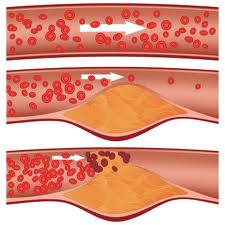 This increases the pressure within blood vessels and results in the heart having to work harder to push this excess volume through the circulation. This results in a vicious circle of hardening of the arteries as well as thickening of the heart muscle resulting in even higher blood pressure and congestive heart failure, chronic kidney disease. Thus starts the cycle of sodium accumulation resulting in even worse “sodium sensitivity” leading to hypertension, heart disease, strokes and kidney disease.
This increases the pressure within blood vessels and results in the heart having to work harder to push this excess volume through the circulation. This results in a vicious circle of hardening of the arteries as well as thickening of the heart muscle resulting in even higher blood pressure and congestive heart failure, chronic kidney disease. Thus starts the cycle of sodium accumulation resulting in even worse “sodium sensitivity” leading to hypertension, heart disease, strokes and kidney disease.
Problem is Wide Spread
75 million people in the US age 20 and older have hypertension (of those, 25% are unaware of their condition). Extensive research has shown that more than 2400 mg of sodium daily as associated with elevated blood pressure. With an average sodium intake of 3000 mg a day, we are all at risk of developing high blood pressure as a result of our food habits.
You Can Easily Turn It Around
Even with modest reduction in sodium intake we can see dramatic improvements in high blood pressure, heart attack risk and its resulting mortality.
In other words, restricting salt saves lives. So how much sodium should you reduce to?
The good news is that it’s easy to reduce your salt intake by gradually cutting back. The taste buds adjust naturally just as our ears adjust to increasing or decreasing the volume of music. By reading labels carefully and choosing fresh, unprocessed and low-sodium foods, substituting for salt whenever possible, we can easily reduce our intake to a more healthy level of 1500 mg a day.
This is low hanging fruit in our quest for wellness!
Be Well!
Dr. Pankaj Vij
Read More...
Slow Down Aging: Avoid 5 Specific Sugar and Fat Felons
The five fluid felons for our health are:
- White Sugar
- Simple Carbohydrates
- Corn Syrup
- Saturated Fat
- Trans-fat
By systematically eliminating these sugar and fats from the diet, we can get rid of the majority of poisons in our food supply which wreak havoc on our metabolism by switching on signals of disease and distress. These fluid felons pull the trigger to start cascade of diseases: all related to weight and metabolism and manifested by obesity, diabetes, high blood pressure, high cholesterol, heart disease and strokes.
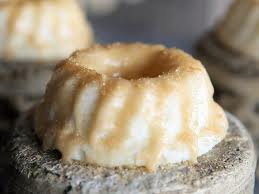
Even though sugar is the primary energy currency of the body, we would still be fine by getting rid of all the white sugar in our diet. In addition, by getting rid of simple carbohydrates (starchy foods with a high glycemic index which are quickly converted to sugar in the body), we can reduce the damaging effects of blood sugar spikes which affects the way cells communicate with each other in the body.
High fructose corn syrup or corn sugar is even worse than white sugar because of the way it overrides the satiety signals and switches on disease processes. This is found in most sweetened foods and beverages because it is inexpensive to produce and has a long shelf life.
Saturated fat and trans-fat are found in red meat and in fried snack foods which are so common in our environment. It would be easy to eliminate saturated fat and trans-fat by cutting down our intake of fast food such as hamburgers and french fries which are staples of our “modern” diet of highly processed, manufactured, inexpensive and convenient food.
The issue is that our body does not even recognize these sugar and fats in our diet and does not know how to process or discard it. So the best prevention is not to include these felons in our diet in the first place. Other than regular exercise, this is the best strategy for slowing down the aging process and age gracefully. This is the closest thing we have to the fountain of youth!
Be Well,
Pankaj Vij MD FACP
Read More...
Healthy Eating Habits: It’s Not What, It’s How You Eat it?
In ancient Vedic times, offering food to the body with love was a ritual. This ritual is almost exactly the same as offering of foods and other things with love to the Gods in presence of fire and asking for their blessings in return. These rituals of offerings with love are found in many corners of the planet in different cultures. Now imagine offering of the food with love to the “fire” (of hunger) in our stomach and asking for blessings of a healthy body in return. Wouldn’t you agree, this is one of the very basic healthy eating habits?
Today we have scientific experiments that support this notion. One such experiment was conducted with rabbits.
One group of rabbits was fed unhealthy cholesterol rich food by throwing the food into their cage. The other group of rabbits was given the same unhealthy food but after holding and petting them with love. Results were startling different. Yes, you guessed it right! The group fed by food thrown into the cage developed heart and circulatory diseases while the group of rabbits fed with love showed a little or no adverse effects on their circulatory system.
Could we not take in food with love to maintain health of our own bodies? Of course we can and we must make time for it. 
If you are still with me, then you must be serious about making a fundamental change in your lifestyle for better health. You will find my passion in my in this and many other articles to inspire people to change. My goal is to awaken the “doctor” in you that you are born with.
Thank you for your time and attention. If you would like to join in my passion then the biggest tribute you can give is by sharing this information with others. You will raise their awareness to small fundamental preventive care tips offered here, promote health and wellness, and change their lives forever. Be Well!
PS: First step in changing your eating habits is to start Eating Suitable Foods not just healthy foods. Learn this know-how in FREE “simple secret to good health” mini course. Subscribe here:
Read More...
Are You eating Ideal Foods or Just Healthy Foods?
Is there a difference between eating healthy foods and ideal foods? Yes, if you would like to eat the foods that are healthy and suitable for YOU! You can select healthy foods based on their fat, type of fat, carbohydrate, protein, sodium, and other contents.
But do you ever stop and think about how the nature (energy) of foods you are taking daily will interact with your unique nature. While it is important to select healthy foods by checking their contents, but for choosing ideal foods you need to go one step further to understand the effect of the food on your unique nature (body type). Download mini-course below to discover your body type (constitution).
Understanding the interactions between the two natures (food and yours) are very important for you. Why, because the interactions can either maintain a balance or create an imbalance in your body. So, even the foods which are healthy can cause imbalance. If you consume such ‘healthy foods’ regularly, the imbalance would accumulate over the years finally showing itself in some form of a disease.
For example, eating raw fresh vegetables are considered healthy. But for some body types these will not be ideal foods. Eating these regularly could cause digestive problems or even cause anxiety, mood swings, or insecure feelings in the mind.
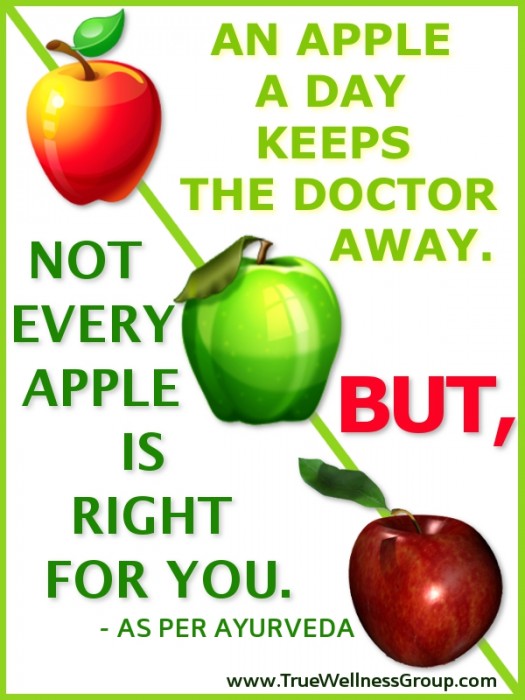 So how do you select ideal foods for yourself from healthy foods? Here Ayurvedic (ancient) medical system comes to the rescue. Unlike modern nutritional systems that recommend ‘one-size-fit-all’ guidelines, Ayurvedic system approaches nutrition based on the uniqueness of an individual.
So how do you select ideal foods for yourself from healthy foods? Here Ayurvedic (ancient) medical system comes to the rescue. Unlike modern nutritional systems that recommend ‘one-size-fit-all’ guidelines, Ayurvedic system approaches nutrition based on the uniqueness of an individual.
Download free Ayurveda body type quiz below.
Once you understand this system, it will be easier for you to prepare ideal meals. For example, hot spicy meals may be good for one body type, but may create problems for another body type. Preparing meals with ‘heavy’ oils may be excellent for one, but may be problematic for another.
To apply this system in your life, you must first understand your own unique nature- mind-body constitution. To help accomplish this, I have created a very basic mini-course that you can download free of charge below or get a copy of “Health + Happiness = Wellness” book with very comprehensive wellness for your unique mind-body. You will discover that your nature and nature of everything you eat and drink are made of 5 elements and 3 energies present in different proportions. The mini course walks you through in determining your nature and the nature of the foods ideal for you.
Remember: All ideal foods for you are healthy foods. However, not all healthy foods are ideal foods for you. The ideal foods not only provide the necessary nutrients but also keep your three energies in balance and do not produce toxins in your body.
Subscribe to FREE mini course below to discover your constitution:
Read More...
How to Prevent Heart Disease with Natural Remedies?
We discussed in the last article how you could find out your risk level long before your cholesterol level goes up and this could give you years of jump on prevention. Even if you discover you are at a higher risk of developing a heart disease, it takes years to develop. Prevention with natural remedies can be too late after you are diagnosed with a disease. However, having years of jump on prevention can completely change the course of your life- prolonging your healthy years and quality of life. 
If you discover your body constitution (subscribe below to discover) is of higher to moderate risk for heart disease then consider taking the following steps on how to prevent heart disease build up. Keep in mind the natural remedies only work if you regularly use them in your diet and life style.
• Keep your cholesterol at healthy levels using natural foods. You can get our free Lower Your Cholesterol Naturally e-book that covers this and much more in great detail when you subscribe to our newsletter
• Incorporate Indian Gooseberry, Amla, in your diet with or after your meal. Amla is a sour tasting fruit that reduces inflammation in the body and is an effective natural home remedy for heart disease. Amount should be taken as directed or consulted with Ayurvedic practitioner. 
• Another excellent way to prevent heart disease is use of raw onions. They are in the family of bulbs like garlic and keep the cholesterol levels healthy by oxidizing excess cholesterol. If you are brave, the most effective way is to take one teaspoon of raw onion juice first thing in the morning.
• Use honey as a sweetener. The heating property of honey is excellent in breaking down fat deposits to prevent all kinds of heart disease. Honey rejuvenates and tones up muscles including heart muscles thus improve the circulation. Consume one tablespoonful daily with or after food.
Caution: As always, consult with your physician and work with your Ayurvedic practitioner before implementing changes in your diet and life style. After implementing changes, closely monitor your progress. Be Well!
Subscribe below to discover your body constitution:
